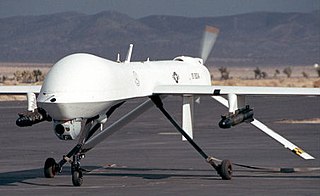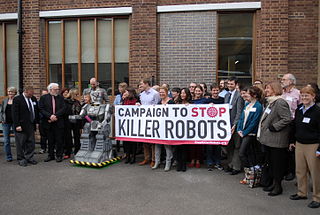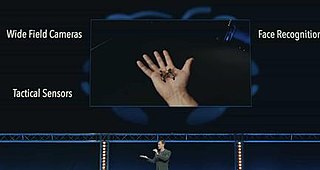An autonomous robot is a robot that acts without recourse to human control. Historic examples include space probes. Modern examples include self-driving vacuums and cars.
Robotic control is the system that contributes to the movement of robots. This involves the mechanical aspects and programmable systems that makes it possible to control robots. Robotics can be controlled by various means including manual, wireless, semi-autonomous, and fully autonomous.

Military robots are autonomous robots or remote-controlled mobile robots designed for military applications, from transport to search & rescue and attack.

An unmanned combat aerial vehicle (UCAV), also known as a combat drone, fighter drone or battlefield UAV, is an unmanned aerial vehicle (UAV) that is used for intelligence, surveillance, target acquisition, and reconnaissance and carries aircraft ordnance such as missiles, anti-tank guided missiles (ATGMs), and/or bombs in hardpoints for drone strikes. These drones are usually under real-time human control, with varying levels of autonomy. UCAVs are used for reconnaissance, attacking targets and returning to base; unlike kamikaze drones which are only made to explode on impact, or surveillance drones which are only for gathering intelligence.

Stuart Jonathan Russell is a British computer scientist known for his contributions to artificial intelligence (AI). He is a professor of computer science at the University of California, Berkeley and was from 2008 to 2011 an adjunct professor of neurological surgery at the University of California, San Francisco. He holds the Smith-Zadeh Chair in Engineering at University of California, Berkeley. He founded and leads the Center for Human-Compatible Artificial Intelligence (CHAI) at UC Berkeley. Russell is the co-author with Peter Norvig of the authoritative textbook of the field of AI: Artificial Intelligence: A Modern Approach used in more than 1,500 universities in 135 countries.

An unmanned ground vehicle (UGV) is a vehicle that operates while in contact with the ground and without an onboard human presence. UGVs can be used for many applications where it may be inconvenient, dangerous, or impossible to have a human operator present. Generally, the vehicle will have a set of sensors to observe the environment, and will either autonomously make decisions about its behavior or pass the information to a human operator at a different location who will control the vehicle through teleoperation.
Robot ethics, sometimes known as "roboethics", concerns ethical problems that occur with robots, such as whether robots pose a threat to humans in the long or short run, whether some uses of robots are problematic, and how robots should be designed such that they act 'ethically'. Alternatively, roboethics refers specifically to the ethics of human behavior towards robots, as robots become increasingly advanced. Robot ethics is a sub-field of ethics of technology, specifically information technology, and it has close links to legal as well as socio-economic concerns. Researchers from diverse areas are beginning to tackle ethical questions about creating robotic technology and implementing it in societies, in a way that will still ensure the safety of the human race.
The SGR-A1 is a type of autonomous sentry gun that was jointly developed by Samsung Techwin and Korea University to assist South Korean troops in the Korean Demilitarized Zone. It is widely considered as the first unit of its kind to have an integrated system that includes surveillance, tracking, firing, and voice recognition. While units of the SGR-A1 have been reportedly deployed, their number is unknown due to the project being "highly classified".
Drone warfare is a form of aerial warfare or marine warfare using unmanned combat aerial vehicles (UCAV) or weaponized commercial unmanned aerial vehicles (UAV). The United States, United Kingdom, Israel, China, South Korea, Iran, Iraq, Italy, France, India, Pakistan, Russia, Turkey, Ukraine and Poland are known to have manufactured operational UCAVs as of 2019.

The Campaign to Stop Killer Robots is a coalition of non-governmental organizations who seek to pre-emptively ban lethal autonomous weapons.

A loitering munition, also known as a suicide drone, kamikaze drone, or exploding drone, is a kind of aerial weapon with a built-in warhead that is typically designed to loiter around a target area until a target is located, then attack the target by crashing into it. Loitering munitions enable faster reaction times against hidden targets that emerge for short periods without placing high-value platforms near the target area and also allow more selective targeting as the attack can be changed mid-flight or aborted.
The International Committee for Robot Arms Control (ICRAC) is a "not-for-profit association committed to the peaceful use of robotics in the service of humanity and the regulation of robot weapons." It is concerned about the dangers that autonomous military robots, or lethal autonomous weapons, pose to peace and international security and to civilians in war.

Slaughterbots is a 2017 arms-control advocacy video presenting a dramatized near-future scenario where swarms of inexpensive microdrones use artificial intelligence and facial recognition software to assassinate political opponents based on preprogrammed criteria. It was released by the Future of Life Institute and Stuart Russell, a professor of computer science at Berkeley. On YouTube, the video quickly went viral, garnering over two million views and was screened at the United Nations Convention on Certain Conventional Weapons meeting in Geneva the same month.
A military artificial intelligence arms race is an arms race between two or more states to develop and deploy lethal autonomous weapons systems (LAWS). Since the mid-2010s, many analysts have noted the emergence of such an arms race between global superpowers for better military AI, driven by increasing geopolitical and military tensions.
The JARI USV is an uncrewed surface vehicle developed by the China Shipbuilding Industry Corporation (CSIC), specifically between its No. 716 Research Institute, the Jiangsu Automation Research Institute (JARI), and No. 702 Research Institute, China Ship Scientific Research Centre (CSRRC). The uncrewed warship is designed for potential use for the People's Liberation Army Navy and export customers.

The HAL Combat Air Teaming System (CATS) is an Indian unmanned and manned combat aircraft air teaming system being developed by Hindustan Aeronautics Limited (HAL). The system will consist of a manned fighter aircraft acting as "mothership" of the system and a set of swarming UAVs and UCAVs governed by the mothership aircraft. A twin-seated HAL Tejas is likely to be the mothership aircraft. Various other sub components of the system are currently under development and will be jointly produced by HAL, National Aerospace Laboratories (NAL), Defence Research and Development Organisation (DRDO) and Newspace Research & Technologies.
Shield AI is an American aerospace and defense technology company based in San Diego, California. It develops artificial intelligence-powered fighter pilots, drones, and technology for defense operations. Its clients include the United States Special Operations Command, US Air Force, US Marine Corps, US Navy and several international militaries.

Collaborative combat aircraft (CCA) is a US program for unmanned combat air vehicles (UCAVs) that is considered broadly equivalent to a loyal wingman. CCAs are intended to operate in collaborative teams with the next generation of manned combat aircraft, including sixth-generation fighters and bombers such as the Northrop Grumman B-21 Raider. Unlike the conventional UCAVs, the CCA incorporates artificial intelligence (AI), denoted an "autonomy package", increasing its survivability on the battlefield. It is still expected to cost much less than a manned aircraft with similar capabilities. The US Air Force plans to spend more than $6 billion on its CCA programs from 2023 to 2028. The success of the CCA program may lessen the need for additional manned squadrons.
A loyal wingman is a proposed type of unmanned combat air vehicle (UCAV) which incorporates artificial intelligence (AI) and is capable of collaborating with the next generation of manned combat aircraft, including sixth-generation fighters and bombers such as the Northrop Grumman B-21 Raider. Also unlike the conventional UCAV, the loyal wingman is expected to be capable of surviving on the battlefield but to be significantly lower-cost than a manned aircraft with similar capabilities. In the US, the concept is known as the collaborative combat aircraft (CCA).
Brave1 is a Government of Ukraine platform to bring together innovative companies with ideas and developments that can be used in the defense of Ukraine, launched on 26 April 2023.










